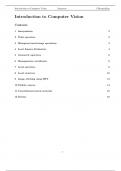College aantekeningen
Volledige tentamenstof Introduction to Computer Vision, Bachelor Informatica &Kunstmatige Intelligentie UvA
Volledige sammenvatting van de tentamenstof voor het vak Introduction to Computer Vision inhet 2e jaar van de bachelors Informatica & Kunstmatige Intelligentie aan de Universiteit van Amsterdam. De samenvatting is in het Engels, net zoals het grootste gedeelte van het vak. Alle hoorcolleges en lec...
[Meer zien]




